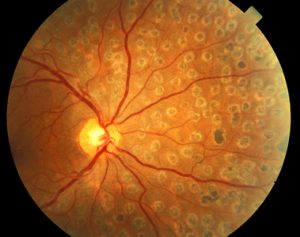During the first three stages of diabetic retinopathy, no treatment is needed, unless you have macular edema. To prevent progression of diabetic retinopathy, people with diabetes should control their levels of blood sugar, blood pressure, and blood cholesterol.
 Proliferative retinopathy is treated with laser surgery. This procedure is called pan-retinal photocoagulation or PRP. PRP helps to shrink the abnormal blood vessels. Your doctor places 1,000 to 2,000 laser burns in the areas of the retina away from the macula, causing the abnormal blood vessels to shrink. Because a high number of laser burns are necessary, two or more sessions usually are required to complete treatment.
Proliferative retinopathy is treated with laser surgery. This procedure is called pan-retinal photocoagulation or PRP. PRP helps to shrink the abnormal blood vessels. Your doctor places 1,000 to 2,000 laser burns in the areas of the retina away from the macula, causing the abnormal blood vessels to shrink. Because a high number of laser burns are necessary, two or more sessions usually are required to complete treatment.
 Although you may notice some loss of your side vision, PRP can save the rest of your sight. PRP may slightly reduce your color vision and night vision. PRP works better before the fragile, new blood vessels have started to bleed. That is why it is important to have regular, comprehensive dilated eye exams. Even if bleeding has started, PRP may still be possible, depending on the amount of bleeding.
Although you may notice some loss of your side vision, PRP can save the rest of your sight. PRP may slightly reduce your color vision and night vision. PRP works better before the fragile, new blood vessels have started to bleed. That is why it is important to have regular, comprehensive dilated eye exams. Even if bleeding has started, PRP may still be possible, depending on the amount of bleeding.
If the bleeding in your eye is severe, you may need a surgical procedure called a vitrectomy. During a vitrectomy, blood is removed from the center of your eye by a retinal specialist.

